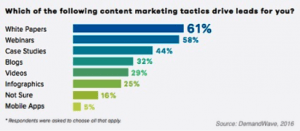The reality is, however, you need organic leads to make sure that your business continues to thrive. Without an influx of new potential clients, growing your brokerage can prove to be difficult in today’s climate of heightened regulation and competition in the insurance industry.
To make your B2B lead generation efforts really count, start by creating a clear, focused channel to apply your energy through.
Begin by developing your buyer personas and from there you can take the next essential steps to reach those primary buyers.
This is how you’ll get the results you need, stay ahead of the competition, and avoid the most common pitfall of insurance marketing – wasting time on lead generation efforts that lack the focus required to attract your target.
1. Identify Your Primary Buyers
This is the absolute first actionable tip you should take in order to ensure that your marketing efforts can go to work for you generating leads.
If you are not clear on who exactly is buying your services, then how do you know how to address your ideal leads or to develop tailored content that will engage, inform, and support your potential future clients?
Start by looking at your current customers.
What do they ‘look’ like?
What industries are the primarily coming from?
What questions would they have about insurance?
How is it that you solve their problems?
From examining your present buyers, you can look at who you would like to expand your marketing efforts to and what type of buyers are the most likely to be interested in your services.
2. Answer Their Questions

Only if you speak to their needs are you likely to trigger interest.
Take the time to brainstorm your buyer personas. Everything from their age range to their likely professional experience is useful for getting a fuller picture of who you are reaching out to and how to best tailor your efforts.
Make a detailed list of the needs of your personas.
Come up with answers to the problems and questions they are facing and determine what information would be the most valuable to them.
- How can your insurance products help their business and alleviate their problems?
- What risks are they most concerned about?
Take into account their needs, taking a detailed look at the current issues that they may face within their industry, as well as projected problems for the future.
3. Develop Your Primary Buyer Personas
This is a critical early step in the business to business marketing process.
Once you have identified and researched who your potential leads are, it’s time to develop the personas.
What are the ingredients of a strong buyer persona?
It is through your own insights and experience with customers, combined with market research, that you can develop your most dynamic, detailed – and accurate – personas.
In order to garner the most info from your current client base, you can use surveys and short interviews. The more feedback that you can get from the customers that you are working with now, the better you can understand their needs and tailor your marketing strategies to potential future clients. Use emails to ask questions and request feedback.
You can also create a questionnaire on your website to ask questions and gain insights from potential customers who may be visiting your website. Tools like Surveymonkey are available to help marketers get that all-valuable customer data.
Another, more personal option, is to call your client list and ask if they have time to answer a few questions for your brokerage.
For market research, there are many tools that you can use in your insurance marketing. Google Analytics, Audience Reports, and Facebook Insights will all help you to learn more about your prospective and current clients.
You can keep track of data like demographics, interests, and locations and use that to improve your personas and craft new ones as and when necessary.
4. Start Slow as You Build Your Own Skill at Creating Personas
One mistake often made is trying to create too many personas, without truly understanding who they are or having a clear distinction between the various characters in their target audience.
As you begin, start with one persona and then build from there. One well-developed primary buyer persona is much more useful than seven poorly developed, poorly researched ones.
Once you are capable of creating distinct, relevant personas, you can expand your ‘persona population.’ Depending on the needs of your brokerage, you could have anywhere between two to six, ideally three or four.
For insurance marketing, it depends on how expansive your client base is.
For example, if your brokerage specialises in commercial insurance, then your range of buyer personas may include:

Corporate Cameron, CFO in charge of the company’s insurance policy and renewals. Has an obligation to put the insurance policy out to tender during drastic changes in the market and does a lot of research as to know what he is talking about during the tender process.’

Business Owner Barry, runs a family business with 5 – 20 staff. Wants to make sure he’s covered for everything, but is also conscious of price. Generally loyal to his broker (until something goes wrong).

New Business Neville, has just started a new business or purchased an existing one. He doesn’t know anything about insurance and is vigilant in his research to ensure he’s got the cover he needs and understands the costs involved. However Neville is generally naive and doesn’t understand the value of insurance.
If you provide products like professional indemnity insurance, to concentrated professions then you would want to work to develop personas for professionals in the various industries that you specialise in, such as:
“Construction Contractor Chris”
“Lawyer Luke”
“Accountant Andrew”
“Financial Advisor Frank”
What matters most to these people?
How can your brokerage help them achieve their goals?
5. Develop Content for Your Personas Only
Your next step is to create valuable lead magnets and content for your buyer personas.
While regular blog and social media posts are the foundation of your lead generation efforts in attracting your buyer personas, to further engage and convert these personas into leads, you will need more dynamic, value-driven content that is catered specifically to their needs.
White papers, eBooks, webinars, informational videos, and other content are hugely effective tools for lead conversion once you have attracted them.
Craft lead magnets that directly answer the needs of your buyer personas. As you have a detailed understanding of what questions and concerns they have about business risk and protecting their professional standing, you can tailor your business to business lead generation efforts around your well-developed personas.
6. Analyse and Refine

business to business lead generation 3.pngIn order to put your best foot forward for generating those B2B leads through your buyer personas, the final step is to analyse your marketing efforts and then use that insight to refine your personas.
With tools like Google Analytics you can look at how attractive your website content is and what visitors are spending the most time focussing on. Gauge the power of your social media presence by looking at your social media likes, shares, and retweets.
The more you know about how successful your lead generation efforts are, the more you can improve your personas.
If you are not engaging the leads that you want, then work on creating more insightful, well-researched buyer personas and content. When you speak directly to your audience, they will listen.
